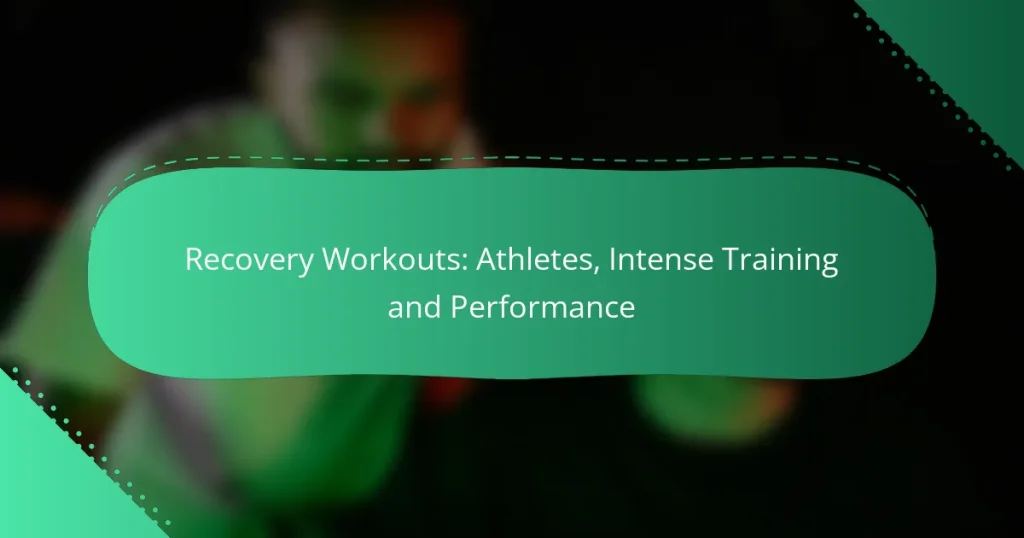Recovery workouts are essential for athletes, as they facilitate the body’s restoration after intense training, enhance performance, and help prevent injuries. By incorporating various techniques aimed at promoting muscle recovery and improving flexibility, these workouts ensure that athletes can maintain their peak performance levels over time.

What Are Effective Recovery Workouts for Athletes?
Effective recovery workouts for athletes focus on restoring the body after intense training sessions, enhancing performance, and preventing injuries. These workouts include a variety of techniques designed to promote muscle recovery, improve flexibility, and maintain overall fitness levels.
Active recovery sessions
Active recovery sessions involve low-intensity activities that help maintain blood flow and promote healing without placing additional strain on the body. Examples include walking, light cycling, or swimming at a relaxed pace. Aim for 20-30 minutes of these activities to facilitate recovery while keeping the body engaged.
Incorporating active recovery into your routine can reduce muscle soreness and stiffness, making it easier to return to high-intensity workouts. Schedule these sessions on rest days or after intense training to maximize their benefits.
Stretching and mobility exercises
Stretching and mobility exercises are essential for maintaining flexibility and range of motion, which can be compromised during intense training. Focus on dynamic stretches before workouts and static stretches afterward to enhance recovery. Incorporate movements targeting major muscle groups, such as hamstrings, quadriceps, and shoulders.
Consider dedicating 10-15 minutes post-workout to static stretching, holding each stretch for 20-30 seconds. This practice can help alleviate tightness and improve overall athletic performance.
Low-intensity cardio
Low-intensity cardio workouts, such as jogging or cycling at a comfortable pace, can aid in recovery by promoting circulation and reducing muscle soreness. These sessions should last between 30-60 minutes and can be performed several times a week, depending on your training schedule.
Choose activities that you enjoy to make these sessions more engaging. Low-intensity cardio not only helps in recovery but also contributes to cardiovascular fitness without overexerting the body.
Foam rolling techniques
Foam rolling is a self-myofascial release technique that helps alleviate muscle tightness and improve blood flow. Spend 10-15 minutes rolling over major muscle groups, focusing on areas that feel particularly tight or sore. Aim for 1-2 minutes per muscle group, applying moderate pressure.
Foam rolling can be especially beneficial after workouts or on rest days, as it aids in muscle recovery and reduces the risk of injury. Be cautious not to roll over bony areas or joints to avoid discomfort.
Hydration and nutrition strategies
Proper hydration and nutrition are critical components of recovery for athletes. Aim to drink water consistently throughout the day, especially before, during, and after workouts. Consider electrolyte-rich drinks after intense sessions to replenish lost minerals.
In terms of nutrition, focus on consuming a balanced diet rich in carbohydrates, proteins, and healthy fats. Post-workout meals should ideally include protein and carbohydrates within 30-60 minutes to support muscle repair and replenish glycogen stores. Examples include a protein shake with a banana or a chicken sandwich on whole-grain bread.

How Do Recovery Workouts Enhance Performance?
Recovery workouts play a crucial role in enhancing athletic performance by promoting muscle recovery, reducing injury risks, and improving overall physical conditioning. These workouts help athletes bounce back from intense training sessions, ensuring they maintain peak performance levels over time.
Improved muscle repair
Recovery workouts facilitate improved muscle repair by increasing blood flow to the muscles, which delivers essential nutrients and oxygen. Techniques such as light aerobic exercises, stretching, and foam rolling can help alleviate soreness and expedite the healing process.
Incorporating active recovery sessions, such as walking or cycling at a low intensity, can significantly enhance muscle recovery. Aim for sessions lasting 20-30 minutes to effectively promote repair without overexertion.
Reduced injury risk
Engaging in recovery workouts can significantly reduce the risk of injuries by allowing the body to adapt to training loads. These sessions help to maintain muscle elasticity and joint stability, which are vital for preventing strains and sprains.
To minimize injury risk, athletes should include mobility exercises and dynamic stretching in their recovery routines. Regularly scheduled recovery days, ideally once or twice a week, can also help prevent overuse injuries.
Increased flexibility
Recovery workouts contribute to increased flexibility by incorporating stretching and mobility exercises that promote a greater range of motion. Improved flexibility can enhance athletic performance by allowing for more efficient movement patterns.
Static stretching post-workout and dynamic stretching during recovery sessions are effective methods to boost flexibility. Aim for at least 10-15 minutes of stretching to see noticeable improvements over time.
Enhanced endurance
Recovery workouts can enhance endurance by allowing the body to adapt to prolonged physical exertion. Light aerobic activities help maintain cardiovascular fitness while promoting recovery from intense training sessions.
Incorporate low-intensity activities like swimming or jogging into recovery days, focusing on duration rather than intensity. Sessions of 30-60 minutes can help sustain endurance levels without adding excessive fatigue.

What Are the Best Recovery Tools for Intense Training?
The best recovery tools for intense training include devices and methods that help reduce muscle soreness, improve circulation, and enhance overall recovery. Key options such as massage guns, compression therapy devices, cold therapy systems, and hydration packs can significantly aid athletes in their recovery process.
Massage guns
Massage guns are handheld devices that deliver rapid bursts of pressure to muscle tissue, promoting blood flow and reducing soreness. They are effective for targeting specific muscle groups and can be used before or after workouts to enhance recovery.
When using a massage gun, start with a low speed and gradually increase intensity based on comfort. Focus on sore areas for about 30 seconds to 2 minutes, ensuring not to overdo it to avoid bruising or irritation.
Compression therapy devices
Compression therapy devices use inflatable sleeves to apply pressure to limbs, improving circulation and reducing swelling. These devices are particularly useful after intense workouts or competitions, as they can help flush out metabolic waste and speed up recovery.
Consider using compression therapy for 20 to 60 minutes post-exercise, adjusting the pressure to a comfortable level. Regular use can lead to noticeable improvements in recovery time and muscle soreness.
Cold therapy systems
Cold therapy systems, such as ice baths or cryotherapy chambers, help reduce inflammation and numb pain in sore muscles. These methods are effective for managing acute injuries and can be incorporated into a recovery routine after intense training sessions.
For ice baths, aim for a duration of 10 to 15 minutes at temperatures around 10-15°C (50-59°F). If using cryotherapy, sessions typically last 2 to 3 minutes, providing a quick and effective way to reduce muscle soreness.
Hydration packs
Hydration packs are essential for maintaining fluid balance during and after intense training. They allow athletes to easily carry and consume fluids, ensuring proper hydration levels are restored post-exercise.
Choose a hydration pack that fits comfortably and has enough capacity for your needs, typically ranging from 1.5 to 3 liters. Regularly refilling and consuming fluids during workouts can help prevent dehydration and enhance recovery.

What Criteria Should Athletes Consider When Choosing Recovery Workouts?
Athletes should consider factors such as training intensity and personal fitness goals when selecting recovery workouts. These criteria help ensure that the chosen recovery methods effectively support performance enhancement and injury prevention.
Training intensity
Training intensity significantly influences the type of recovery workout an athlete should choose. Higher intensity workouts typically require more comprehensive recovery strategies, such as active recovery sessions that include low-impact activities like swimming or cycling. Conversely, lower intensity training may allow for lighter recovery methods, such as stretching or yoga.
To gauge the appropriate recovery approach, athletes can assess their exertion levels during workouts. For example, if training sessions consistently reach 80% of maximum effort, incorporating longer recovery periods or more restorative practices is advisable. This ensures the body has adequate time to repair and adapt.
Personal fitness goals
Personal fitness goals play a crucial role in determining the most effective recovery workouts. Athletes focused on building strength may prioritize recovery techniques that enhance muscle repair, such as foam rolling or targeted stretching. In contrast, those aiming for endurance might benefit from longer, low-intensity activities that promote blood flow and reduce soreness.
It’s essential to align recovery workouts with specific objectives. For instance, if an athlete is preparing for a marathon, incorporating recovery runs or light jogs can help maintain fitness levels while allowing the body to recover. Regularly reassessing these goals can help athletes adjust their recovery strategies as needed to optimize performance.

